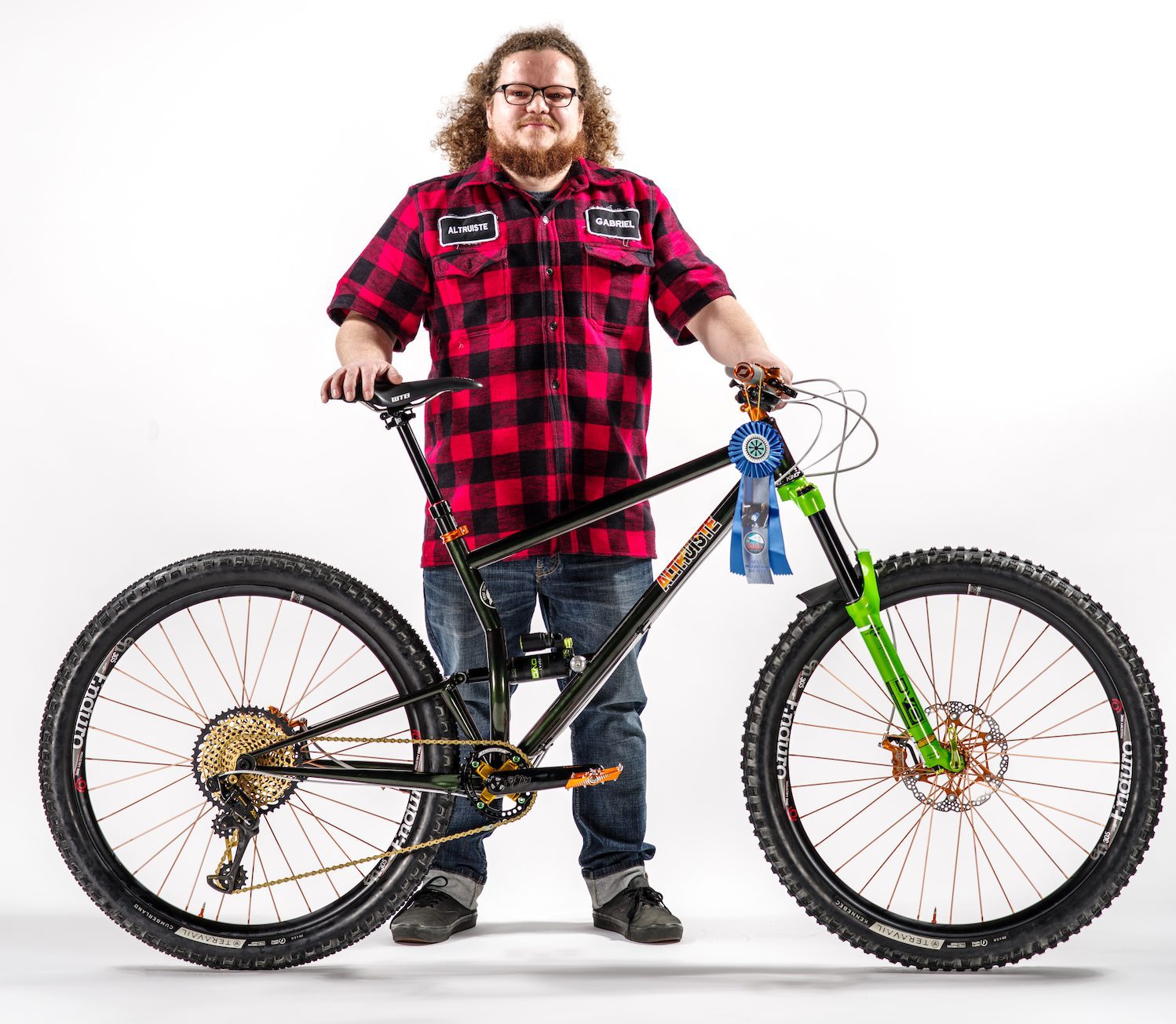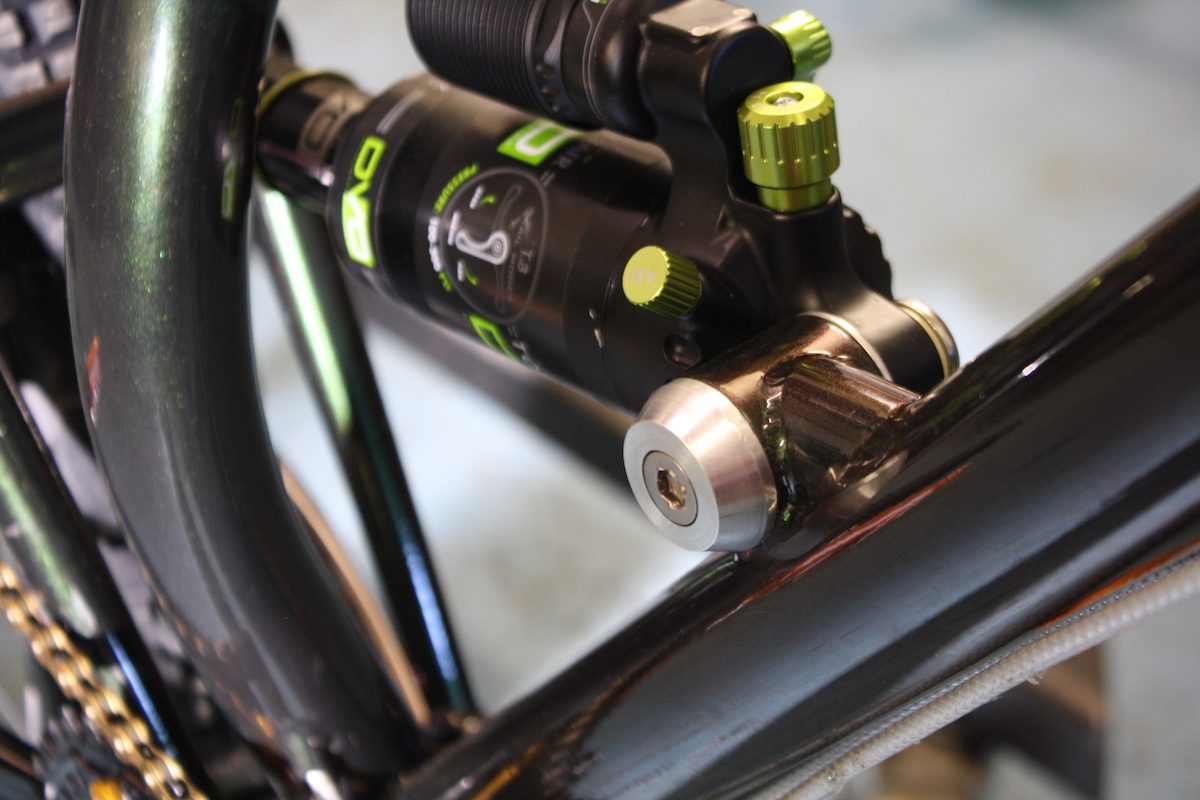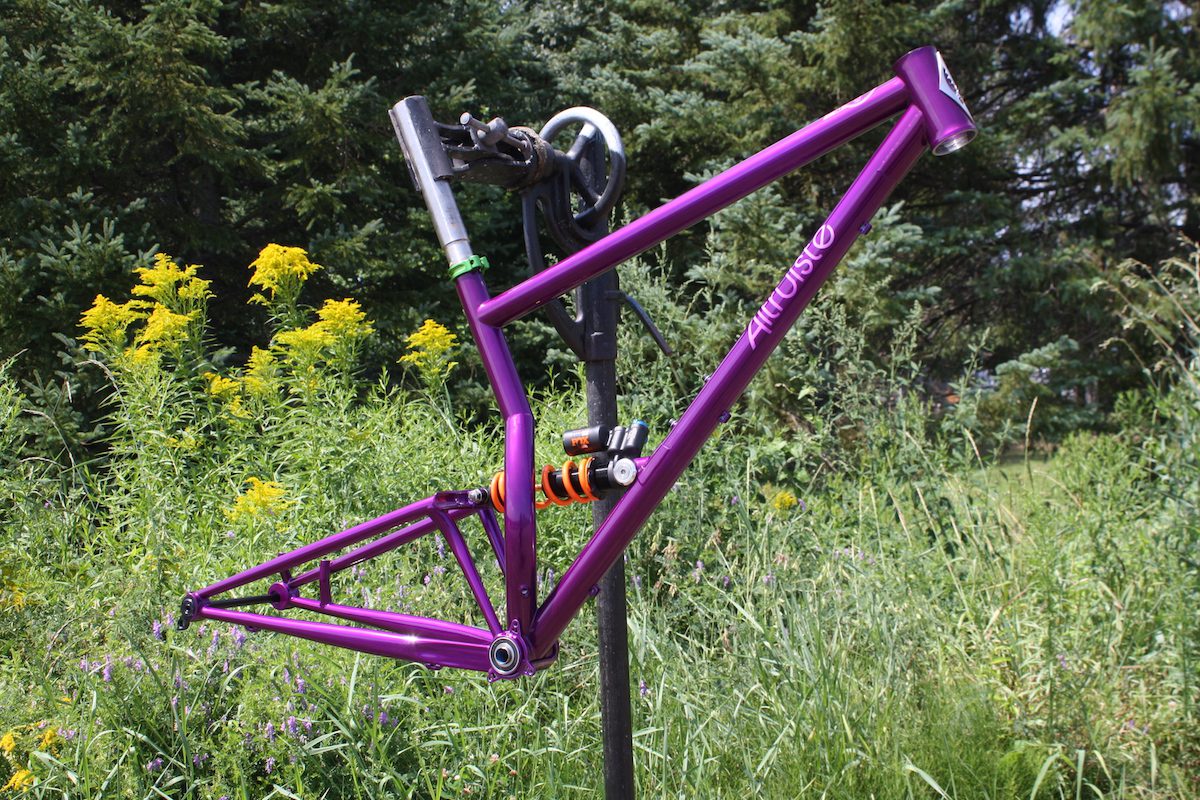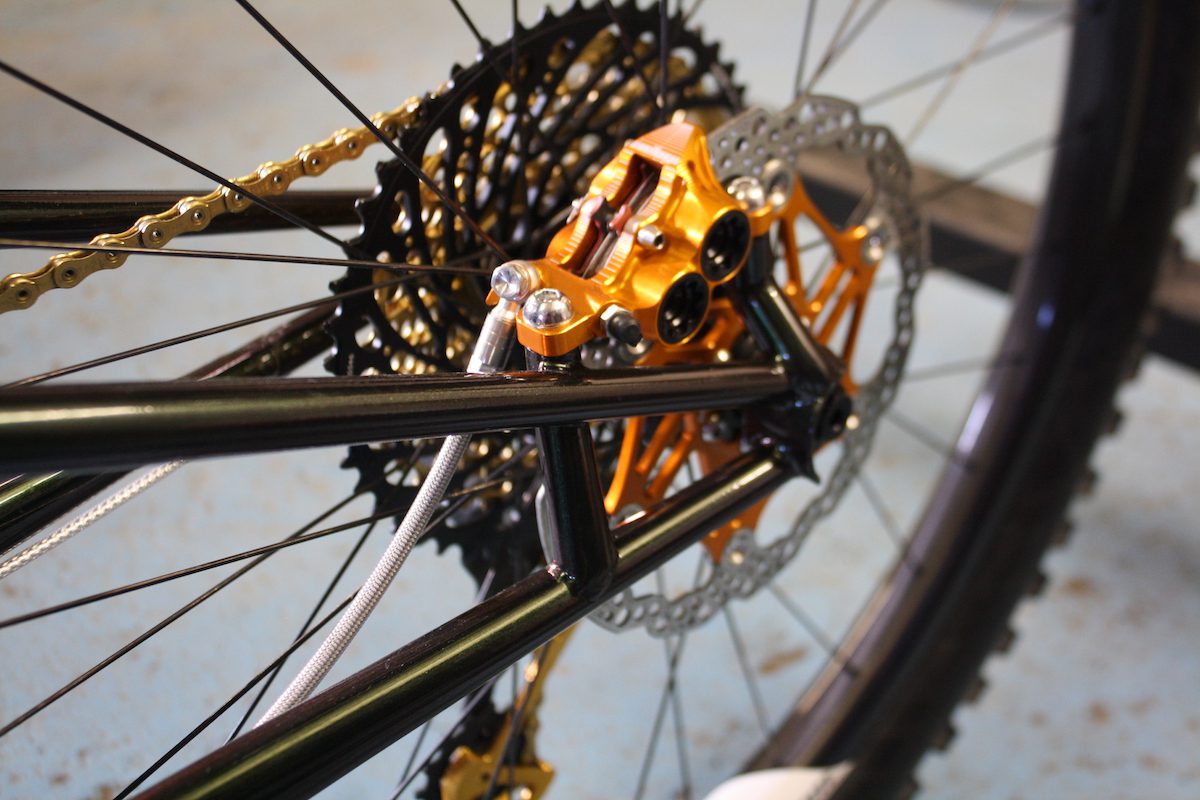From NAHBS to now: Gabriel Lang looks back on a big year for Altruiste
Ups and downs after the east coast Canadian frame builders 2018 surprise Best in Show win

When Altruiste Bicycles’ asymmetric steel enduro bike, the Fundy, won Best Mountain Bike at the 2018 North American Handmade Bicycle Show, people were surprised.
When it won Best in Show as the best bike of any kind at NAHBS it caught people off guard, including the bikes builder, Gabriel Lang. Immediately following the win, Lang looked like he was having a hard time believing he’d won the award. When I talked to him at home in New Brunswick a year after his big win, he said that that feeling lasted long after he left the award show.

Since 2012, Lang has been building under the name Altruiste in Notre Dame, New Brunswick. Before that, he was part of the Montreal-based Dobermann Bikes Co., where he first started welding bikes back in 2006. While the Fundy is a steel enduro-worthy bike, Altruiste makes everything from track bikes to, maybe one day, downhill.
RELATED: Canada’s No. 22 recognized as Best in Show at 2019 NAHBS
As NAHBS standard media frenzy turned its attention to Sacramento, California for the 2019 show, I caught up with Lang, who was at home in Notre Dame working away on new builds. He shares how winning Best in Show has impacted him professionally, but also the personal impact it had on him, and the challenges he faced in the wake of that attention. One year later, he has advice for aspiring Canadian builders and talks about the wild lead-up to NAHBS 2018, being the “token friendly Canadian,” the legacy of Dobermann, The Rise, and plans for a steel downhill Altruiste.

Canadian Cycling Magazine: What were your expectations going in NAHBS last year?
Gabriel Lang: I had zero expectations, I just wanted to make it down there, you know? I pretty much work alone, it’s a one-and-a-half-man show. It’s just me, with some help from my wife and occasionally some friends. On top of all the orders I had to build, I had to get ready for NAHBS.
Just getting to the show came down to the wire. The night before we were supposed to leave, I was at the paint shop. My powdercoat guy gave me the keys to the shop, and said, “Listen you’ve done this before. Just lock the door when you’re done.” So I was driving back to my shop in the middle of the night with frames literally still warm from the powdercoat oven. It was complete hell!
RELATED: Everything NAHBS – 2019 North American Handmade Bicycle Show
We were slowed down at the border because my customs papers weren’t in check, that slowed us down a couple hours. My buddy who came with me and I stayed up all night in the hotel room building bikes, then set up in the morning. We were still building bikes as the show was starting.
I knew the order they were calling the different prize categories for the bikes to be judged, so I knew we had about an hour and a half to finish building up the enduro bike. 15 minutes later, they shuffled around some categories and I hear over the intercom “All registered entries for the best mountain bike category please show up to the judges stand.” The bike wasn’t even ready, the seat post was holding with electrical tape inside the seat tube. I put the seat collar over top to make it look done.
As they were closing those big conference hall divider curtains, I ran up yelling “wait wait wait!” I basically threw the bike, and as they took it all the judges turned around and were like “Woooah!” And I thought, “alright, maybe this bike will lead to something good.”
Just being there barely happened, so winning anything was the furthest thing from my mind. It was in-tense.
What was it like after you won the Best in Show award?
It was completely surreal. It still is completely surreal. All these legends, all these builders that I’ve looked up to ever since I was old enough to know what a bike was, I mean, these are people that literally invented my craft. They created these systems and mechanisms that I now use. Then, according to some people at that show, my bike was better than what these guys do. To me, that doesn’t make any sense, right? In my mind, still to this day, I don’t come up to the ankle of these legends. The Steve Potts’, the Eriksen’s, all these legendary builders. It’s completely surreal. It’s like if some little Indy rock and roll band won the Best Album at the … Emmy? No?
Oscar? No… (neither of us can come up with Grammy)
It doesn’t make any sense, it’s completely ridiculous. Immediately after winning it was just a blur. If you go back and watch the video’s on Facebook, right after they call my name I turn around and hug the judge and hug Don Walker, the President and owner of NAHBS because if I didn’t do that I was about to break down and cry. I had to immediately do something, because it was too overwhelming.
But you do have a fair amount of experience yourself at this point. You started working with Dobermann in 2006, almost 12 years ago. And two bikes you designed there, like the Le Pink and Stella DH, still have a following today.
You know what, that means more to me, to be honest, than any industry award. To make something that means so much to someone that can have that big of an impact on someone – that’s why I do this.
I had a guy recently call me and talk for two hours. He had sold his Dobermann Le Pink years ago, and then started this two-year quest to find it, and eventually able to buy it back and he was just so stoked. These bikes are being loved by people who ride them, and who get what I wanted to accomplish with these bikes. I wanted the bikes to handle in a certain way and have certain characteristics. And the people that love them, love them because of these characteristics.
Not to say that the award isn’t important. I’m still very honored that they chose me. It’s had a big impact, but the change from that has been more internal, within me. It really made me look inside myself and see what I wanted.
I build bikes for riders, to be ridden. I have a certain style and when people understand what I’m trying to accomplish and like what I do, that makes more sense than having a show bike and having people say it’s the best bike amongst 200 completely unrelated bikes.
What effect did winning Best in Show have on your business?
The was a bump in sales right away, but no wild increase. I think the difference now is I get a lot more people interested in me personally. And that now I’m kind of on the ‘list’ when people start looking for a bike. It’s “Oh I’m thinking of x, y and Altruiste.”
We’re now a year out from the Best in Show award. How has winning that changed your approach to building?
Last year was both the worst and the best year I’ve ever had. I’ve learnt so much about myself personally, about the industry that I’m in, about how to run my business a certain way. There’s definitely going to be “Before NAHBS” and “After NAHBS” in my life.
To me, that being such an impossible achievement, I’ve lived through a really strong impostor syndrome, thinking “I don’t deserve this, it’s not fair, someone else should have won.” I’m not a very center-of-attention sort of guy. I’m really secluded on the East Coast here where I’ve got a little scene, but it’s very quiet and I really appreciate my solitude. So to be put in the spotlight in such a way, really affected me. It opened up a lot of things to learn about myself and where I should steer this business towards. You know, what side of the industry I like, what side of the industry I dislike, and how, personally, I should transition into these areas. And also, how to transition my business in a way that keeps things fun, but also profitable. I want to keep doing this for a long time, but it has to be fun.
Winning this prize put me face to face with all these decisions, and all these discoveries and things that I’ve learned. It wasn’t easy, but I’m super happy that I’ve had to face all these difficulties and challenges. Now, a year after, I’m much better off, a smarter person, and a much more experienced person. I think I’m much better equipped to face the future. Yes, winning the prize brought me a whole bunch of sales and notoriety and visibility. But I think the greatest thing it brought me was this opportunity for introspection and an opportunity to discover and learn all these things I wouldn’t have had I not won the prize. That, I realize no, is extremely valuable.
One thing about having a business is, when you think you know enough you realize you actually know nothing. So I know there’s still a whole bunch of stuff to learn.

There’s a strong tradition of frame building in Quebec, from Dobermamn all the way back to Balfa and Xprezo, Devinci and others. What does it mean to bring that back out east to New Brunswick?
There was actually a really popular builder in northern New Brunswick called Porter. They were very big in the late 90’s. They built aluminum road bikes for the Canadian cycling team. They had a very cool downhill frame that was kind of a copy of the Intense M1, with a FSR-type suspension. They did some really cool stuff.
But I was talking about that this week, actually. I feel like I’m probably the most isolated frame builder in the world. In Quebec there’s this crew of people that ride together and influence each other and hang out. There’s Philippe Benoit, one of the original Balfa guys, the Devinici crew, there’s T-Lab and Daam built in Montreal, Guillaume Désy. In Colorado they have their crew, same in California, in the Carolina’s there’s Cane Creek and Industry Nine – everybody has their own local scene.
Then there’s me on the Canadian east coast with nobody. There are biking clubs and bike shops but there’s no frame builders of components manufactures. I’m stuck here alone in my shop and it kind of influences my style in that I’m free to do my own stuff. I’m not stuck in a certain style, whether that’s Marin County or North Shore, B.C. style, I’m really free to create my own designs, my own way of imagining the bicycles.
There’s no one telling you “don’t do this, or don’t do that…”
You go to Colorado and there’s like, 15 builders all sharing resources and influences. There’s a big pool of potential customers and riders as well, right? As opposed to here, where I’ve been in business for almost five years and I’ve sold three frames in New Brunswick. We’re a province of 750,000 people, there’s not a lot of people around here. So the market really is the world, right?
So I’m isolated, but at the same time I have to make myself really accessible to Asia to Europe, to the U.S. I have to find a way to reach these people, right? Because (laughing) there not going to come to me.
So are most of your frames going International then, or are they staying in Canada?
Oh, it’s mostly international. Maybe one third stay in Canada. It’s got no choice but to be like that. There’s already a pretty strong Canadian market with big name builders, especially out west. You guys are pretty well served with Chis Dekerf, Naked, there’s a whole bunch. Legends!
Having gone through that whole experience at the show, and in the year since, what advice do you have for other Canadians? Whether they’re looking to attend NAHBS, or just get into frame building.
If they have the opportunity, they should definitely do it, but they have to make themselves available and approachable. One of the things I’ve discovered in the last year is that I, myself as a person, am as much part of the brand as the frame itself. That type of customer is looking for an experience as much as a bike that represents what they want. Yes, you’re selling your frames, but they’re also looking for a builder that they’ll exchange calls and e-mail’s with that they jive with on a personal level as they go through that process of having a frame built.
I think that was one of my strengths at these shows. I’m the guy at these shows walking around in front of my booth intercepting people. I really enjoy being that token friendly east coast Canadian Maritimer kind of a guy. Back when a friend and I went to NAHBS for the first time in 2015, the business was six months old. Nobody knew who I was, I barely knew anybody there. At the end of the weekend, I had made a whole bunch of friends, the media had seen me, my social media exploded. All just because I had made myself available and people enjoyed talking to me. So all the new builders have to go, but you have to sell yourself. You can’t be ashamed to sell yourself, because you’re as much a part of the product as your frame.
I think that as Canadians we have an edge. From coast to coast we have that natural friendliness. We don’t look menacing, we don’t look scary. People always ask where I’m from, expecting some random state, but when I say Eastern Canada, they always respond, “Oh really?!” They respond really positively.
You can’t try to please everyone. Your product will not please everyone and you as a person won’t jive with everyone. But you have to be proud of what you’ve got. And really, everyone there is friendly. There’s no competition. All the builders are in the same boat, everyone is super friendly. Everyone shares ideas and is so encouraging. It’s really like a big family, there’s this kinship amongst builders. Most of us have all been through the same adventures, we all have the same burns on our bodies in roughly the same spots from building our frames. It’s intimidating at first, but everyone’s there to see everyone else’s success.
You’re not at NAHBS again this year, though?
It was on the West Coast this year, and for me, out on the East Coast, there’s a lot of time and logistics involved. It’s time that I don’t have at the moment. If possible, I’d encourage every builder to go at the very least once.

You’re not at the show, but do you have any special projects or bikes that happen to be taking place at the same time?
Yeah! I’ve got a 27.5-plus bike coming out with a really cool retro vibe to it. It’s like if 1987 met a modern plus bike. I have this super weird, belt-driven, Di2, Alpine, internally geared super commuter type of bike with a dropper post and water bottle mounts galore, some kind of post-apocalyptic end-of-the-world type commuter sort of thing. I have a track bike heading to Hong Kong with a funky paint job.
Michel from The Rise is coming over next week and we’re going to build 33 frames. That’s going to be one hell of a challenge. That’s on a whole other spectrum: full on production for two weeks, then right back to custom.
You build the Partymaster frame for The Rise. How did that come about? What’s your history with The Rise?
There was this indoor skate park in Montreal called U.A.B. – Ugly Ass Bikes – and the boys, Michel Plonka, Vince Allard, and all them would ride there all the time.
I was maybe 18 or 19 at the time, and these guys were maybe 13, 14 years old, just kids. Then Michel Plonka won a Dobermann Frame at a competition, or something like that. Then, a few months later, I had just finished my welding class, and someone told me the guys at Dobermann were looking for a welder. So I applied, and got the job.
Eventually, all these kids either ended up buying Dobermanns, or buying them second hand, getting sponsored or winning them at competitions. We’d all go to events and competitions together, and it kind of became the big Dobermann family. When I left Dobermann in 2010, it kept going for a while. When it ended, the guys from The Rise started riding these weird Eastern European brand Taiwanese-made frames. They kept breaking and the relationship with these companies wasn’t all that good.
I told them, “Listen, I’m working on a company for the last 3-4 years, and it’s almost ready to go. Are you interested in working on this project together?” They’d had The Rise for a couple years, and had been selling t-shirts and stuff like that for a few years, and figured it was probably a good idea to have their own frame.
So we started designing. I put in my ideas, they put in there ideas, and we build a few prototypes. Then we launched the frames! I think we have 110 sold so far, which is pretty good for that sort of product in today’s market.
They’re such good guys, they’re so dedicated to riding and to the scene. They live for riding bikes, riding street and park, it’s their reason for being. It’s really inspiring.
The original teaser video for The Rise
On the new project front, you made a titanium version of the Zydeco frame. Is that something that’s going to be regular? Or was that a one-off project?
So far it’s just a one-off. Titanium is a whole other beast. It’s so time consuming and you have to do absolutely everything right. It was a very rewarding project but, if I am going to make it a regular thing, it’s going to be a pretty expensive frame because it takes a lot of time to make it right.
When you were at Dobermann, you helped design the Stella. If the Zydeco is an extension of the Le Pink, is there any plan to bring the Stella DH to Altruiste?
What I’m going to do is probably build a downhill version of the Fundy. The Fundy enduro design, tweaked with a longer shock, more travel, more DH geometry, and see how far I can push the concentric BB pivot. It was the victim of a lot of bad press, but it offers a lot of really cool advantages. It’s simple, light, and offers massive traction. It has all these little traits that I think would work really well on a downhill bike. The Fundy comes in close to aluminum frame weight, or carbon fibre, but with the advantages of a steel frame, so for a steel bike, it’s light. I think it’d be fun and that it would work.
You made a limited run of the Fundy’s after NAHBS, are those all gone?
I still have a few. There’s a two that have been built, and there’s a build list of a few more that were sold. And, you know – if people want them, I’m going to build them.


